1. WHO. Nutrition in Adolescence: Issues and Challenges for the Health Sector. Issues in Adolescent Health and Development. 2005. Geneva: WHO.
2. Key JD, Key LL Jr. Calcium needs of adolescents. Curr Opin Pediatr. 1994; 6:379–382. PMID:
7951657.

3. Lifshitz F, Tarim O, Smith MM. Nutrition in adolescence. Endocrinol Metab Clin North Am. 1993; 22:673–683. PMID:
8243454.

4. Ebbeling CB, Feldman HA, Osganian SK, Chomitz VR, Ellenbogen SJ, Ludwig DS. Effects of decreasing sugar-sweetened beverage consumption on body weight in adolescents: a randomized, controlled pilot study. Pediatrics. 2006; 117:673–680. PMID:
16510646.

5. Phillips SM, Bandini LG, Naumova EN, Cyr H, Colclough S, Dietz WH, Must A. Energy-dense snack food intake in adolescence: longitudinal relationship to weight and fatness. Obes Res. 2004; 12:461–472. PMID:
15044663.

6. Striegel-Moore RH, Thompson D, Affenito SG, Franko DL, Obarzanek E, Barton BA, Schreiber GB, Daniels SR, Schmidt M, Crawford PB. Correlates of beverage intake in adolescent girls: the National Heart, Lung, and Blood Institute Growth and Health Study. J Pediatr. 2006; 148:183–187. PMID:
16492426.

7. Bowman SA, Gortmaker SL, Ebbeling CB, Pereira MA, Ludwig DS. Effects of fast-food consumption on energy intake and diet quality among children in a national household survey. Pediatrics. 2004; 113:112–118. PMID:
14702458.

8. Niemeier HM, Raynor HA, Lloyd-Richardson EE, Rogers ML, Wing RR. Fast food consumption and breakfast skipping: predictors of weight gain from adolescence to adulthood in a nationally representative sample. J Adolesc Health. 2006; 39:842–849. PMID:
17116514.

9. Thompson OM, Ballew C, Resnicow K, Must A, Bandini LG, Cyr H, Dietz WH. Food purchased away from home as a predictor of change in BMI z-score among girls. Int J Obes Relat Metab Disord. 2004; 28:282–289. PMID:
14647177.

10. Zhu K, Du X, Greenfield H, Zhang Q, Ma G, Hu X, Fraser DR. Bone mass in Chinese premenarcheal girls: the roles of body composition, calcium intake and physical activity. Br J Nutr. 2004; 92:985–993. PMID:
15613261.

11. Chan GM, Hoffman K, McMurry M. Effects of dairy products on bone and body composition in pubertal girls. J Pediatr. 1995; 126:551–556. PMID:
7699532.

12. Du XQ, Greenfield H, Fraser DR, Ge KY, Liu ZH, He W. Milk consumption and bone mineral content in Chinese adolescent girls. Bone. 2002; 30:521–528. PMID:
11882468.

13. Prynne CJ, Mishra GD, O'Connell MA, Muniz G, Laskey MA, Yan L, Prentice A, Ginty F. Fruit and vegetable intakes and bone mineral status: a cross sectional study in 5 age and sex cohorts. Am J Clin Nutr. 2006; 83:1420–1428. PMID:
16789345.
14. Cooper C, Eriksson JG, Forsén T, Osmond C, Tuomilehto J, Barker DJ. Maternal height, childhood growth and risk of hip fracture in later life: a longitudinal study. Osteoporos Int. 2001; 12:623–629. PMID:
11580075.

15. Ministry of Health and Welfare. Korea Health Statistics 2009: Korea National Health and Nutrition Examination Survey (KNHANES IV-3).
16. Hu FB. Dietary pattern analysis: a new direction in nutritional epidemiology. Curr Opin Lipidol. 2002; 13:3–9. PMID:
11790957.

17. Kant AK. Dietary patterns and health outcomes. J Am Diet Assoc. 2004; 104:615–635. PMID:
15054348.

18. Tucker KL, Chen H, Hannan MT, Cupples LA, Wilson PW, Felson D, Kiel DP. Bone mineral density and dietary patterns in older adults: the Framingham Osteoporosis Study. Am J Clin Nutr. 2002; 76:245–252. PMID:
12081842.

19. Newby PK, Muller D, Hallfrisch J, Andres R, Tucker KL. Food patterns measured by factor analysis and anthropometric changes in adults. Am J Clin Nutr. 2004; 80:504–513. PMID:
15277177.

20. Newby PK, Muller D, Hallfrisch J, Qiao N, Andres R, Tucker KL. Dietary patterns and changes in body mass index and waist circumference in adults. Am J Clin Nutr. 2003; 77:1417–1425. PMID:
12791618.

21. Johnson L, Mander AP, Jones LR, Emmett PM, Jebb SA. Energy-dense, low-fiber, high-fat dietary pattern is associated with increased fatness in childhood. Am J Clin Nutr. 2008; 87:846–854. PMID:
18400706.

22. Song Y, Park MJ, Paik HY, Joung H. Secular trends in dietary patterns and obesity-related risk factors in Korean adolescents aged 10-19 years. Int J Obes (Lond). 2010; 34:48–56. PMID:
19823182.

23. Hoffmann K, Schulze MB, Schienkiewitz A, Nöthlings U, Boeing H. Application of a new statistical method to derive dietary patterns in nutritional epidemiology. Am J Epidemiol. 2004; 159:935–944. PMID:
15128605.

24. Schulz M, Nöthlings U, Hoffmann K, Bergmann MM, Boeing H. Identification of a food pattern characterized by high-fiber and low-fat food choices associated with low prospective weight change in the EPIC-Potsdam cohort. J Nutr. 2005; 135:1183–1189. PMID:
15867301.

25. Wosje KS, Binkley TL, Fahrenwald NL, Specker BL. High bone mass in a female Hutterite population. J Bone Miner Res. 2000; 15:1429–1436. PMID:
10934640.

26. Drogan D, Hoffmann K, Schulz M, Bergmann MM, Boeing H, Weikert C. A food pattern predicting prospective weight change is associated with risk of fatal but not with nonfatal cardiovascular disease. J Nutr. 2007; 137:1961–1967. PMID:
17634271.

27. Heidemann C, Hoffmann K, Spranger J, Klipstein-Grobusch K, Möhlig M, Pfeiffer AF, Boeing H. European Prospective Investigation into Cancer and Nutrition (EPIC)--Potsdam Study Cohort. A dietary pattern protective against type 2 diabetes in the European Prospective Investigation into Cancer and Nutrition (EPIC)--Potsdam Study cohort. Diabetologia. 2005; 48:1126–1134. PMID:
15889235.

28. Schulze MB, Hoffmann K, Manson JE, Willett WC, Meigs JB, Weikert C, Heidemann C, Colditz GA, Hu FB. Dietary pattern, inflammation, and incidence of type 2 diabetes in women. Am J Clin Nutr. 2005; 82:675–684. PMID:
16155283.

29. Nettleton JA, Steffen LM, Schulze MB, Jenny NS, Barr RG, Bertoni AG, Jacobs DR Jr. Associations between markers of subclinical atherosclerosis and dietary patterns derived by principal components analysis and reduced rank regression in the Multi-Ethnic Study of Atherosclerosis (MESA). Am J Clin Nutr. 2007; 85:1615–1625. PMID:
17556701.

30. Weikert C, Hoffmann K, Dierkes J, Zyriax BC, Klipstein-Grobusch K, Schulze MB, Jung R, Windler E, Boeing H. A homocysteine metabolism-related dietary pattern and the risk of coronary heart disease in two independent German study populations. J Nutr. 2005; 135:1981–1988. PMID:
16046726.

31. Paik H, Kim K. DS24. 1997. Seoul: Seoul Nation University, Human Nutrition Lab. & Sookmyung Women's University, AI/DB Lab.
32. Li SJ, Paik HY, Joung H. Dietary patterns are associated with sexual maturation in Korean children. Br J Nutr. 2006; 95:817–823. PMID:
16571162.

33. Tanner JM. Growth at Adolescence. 1962. London: Blackwell Scientific Publications.
34. Heaney RP, Abrams S, Dawson-Hughes B, Looker A, Marcus R, Matkovic V, Weaver C. Peak bone mass. Osteoporos Int. 2000; 11:985–1009. PMID:
11256898.

35. Nilsson M, Ohlsson C, Eriksson AL, Frändin K, Karlsson M, Ljunggren O, Mellström D, Lorentzon M. Competitive physical activity early in life is associated with bone mineral density in elderly Swedish men. Osteoporos Int. 2008; 19:1557–1566. PMID:
18373050.

36. Nikander R, Sievänen H, Heinonen A, Daly RM, Uusi-Rasi K, Kannus P. Targeted exercise against osteoporosis: A systematic review and meta-analysis for optimising bone strength throughout life. BMC Med. 2010; 8:47. PMID:
20663158.

37. Okubo H, Sasaki S, Horiguchi H, Oguma E, Miyamoto K, Hosoi Y, Kim MK, Kayama F. Dietary patterns associated with bone mineral density in premenopausal Japanese farmwomen. Am J Clin Nutr. 2006; 83:1185–1192. PMID:
16685064.

38. Kontogianni MD, Melistas L, Yannakoulia M, Malagaris I, Panagiotakos DB, Yiannakouris N. Association between dietary patterns and indices of bone mass in a sample of Mediterranean women. Nutrition. 2009; 25:165–171. PMID:
18849146.

39. Lin PH, Ginty F, Appel LJ, Aickin M, Bohannon A, Garnero P, Barclay D, Svetkey LP. The DASH diet and sodium reduction improve markers of bone turnover and calcium metabolism in adults. J Nutr. 2003; 133:3130–3136. PMID:
14519796.

40. McNaughton SA, Ball K, Mishra GD, Crawford DA. Dietary patterns of adolescents and risk of obesity and hypertension. J Nutr. 2008; 138:364–370. PMID:
18203905.

41. Heaney RP. Calcium, dairy products and osteoporosis. J Am Coll Nutr. 2000; 19:83S–99S. PMID:
10759135.

42. Tylavsky FA, Holliday K, Danish R, Womack C, Norwood J, Carbone L. Fruit and vegetable intakes are an independent predictor of bone size in early pubertal children. Am J Clin Nutr. 2004; 79:311–317. PMID:
14749239.

43. Gunnes M, Lehmann EH. Dietary calcium, saturated fat, fiber and vitamin C as predictors of forearm cortical and trabecular bone mineral density in healthy children and adolescents. Acta Paediatr. 1995; 84:388–392. PMID:
7795347.

44. Schönaü E, Wentzlik U, Michalk D, Scheidhauer K, Klein K. Is there an increase of bone density in children? Lancet. 1993; 342:689–690.

45. Siervogel RM, Demerath EW, Schubert C, Remsberg KE, Chumlea WC, Sun S, Czerwinski SA, Towne B. Puberty and body composition. Horm Res. 2003; 60:36–45. PMID:
12955016.

46. Schiessl H, Frost HM, Jee WS. Estrogen and bone-muscle strength and mass relationships. Bone. 1998; 22:1–6. PMID:
9437507.

47. Cutler GB Jr. The role of estrogen in bone growth and maturation during childhood and adolescence. J Steroid Biochem Mol Biol. 1997; 61:141–144. PMID:
9365183.

48. van Lenthe FJ, Kemper CG, van Mechelen W. Rapid maturation in adolescence results in greater obesity in adulthood: the Amsterdam Growth and Health Study. Am J Clin Nutr. 1996; 64:18–24. PMID:
8669409.

49. Szucs J, Jonson R, Granhed H, Hansson T. Accuracy, precision, and homogeneity effects in the determination of the bone mineral content with dual photon absorptiometry in the heel bone. Bone. 1992; 13:179–183. PMID:
1576015.

50. Yamada M, Ito M, Hayashi K, Nakamura T. Calcaneus as a site for assessment of bone mineral density: evaluation in cadavers and healthy volunteers. AJR Am J Roentgenol. 1993; 161:621–627. PMID:
8352120.

51. Rautava E, Lehtonen-Veromaa M, Kautiainen H, Kajander S, Heinonen OJ, Viikari J, Möttönen T. The reduction of physical activity reflects on the bone mass among young females: a follow-up study of 142 adolescent girls. Osteoporos Int. 2007; 18:915–922. PMID:
17211530.

52. Foo LH, Zhang Q, Zhu K, Ma G, Greenfield H, Fraser DR. Influence of body composition, muscle strength, diet and physical activity on total body and forearm bone mass in Chinese adolescent girls. Br J Nutr. 2007; 98:1281–1287. PMID:
17640423.

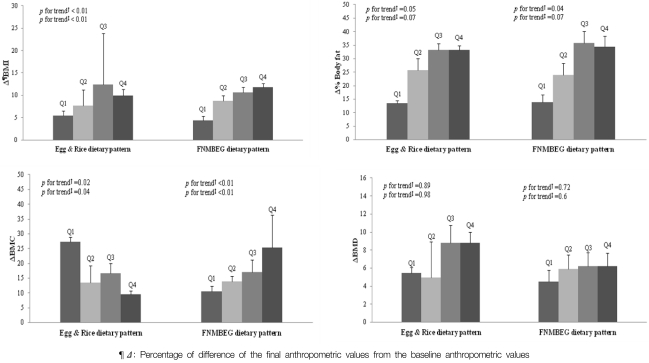

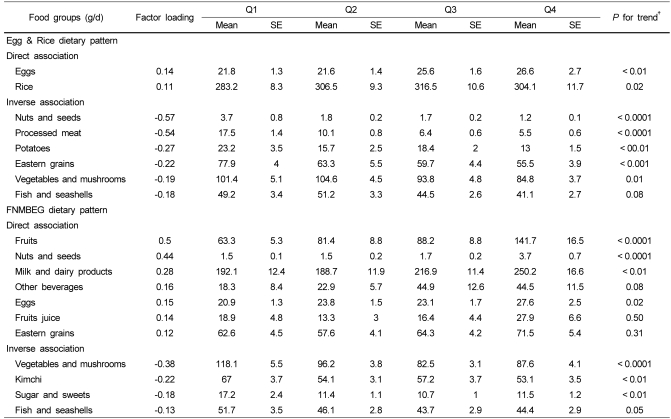
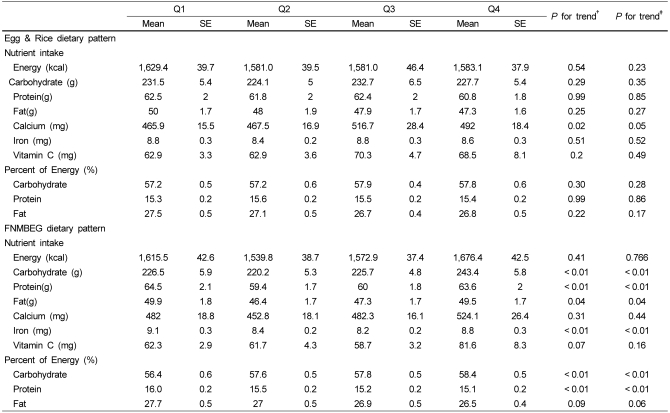




 PDF
PDF ePub
ePub Citation
Citation Print
Print


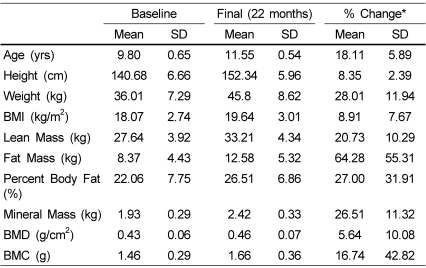
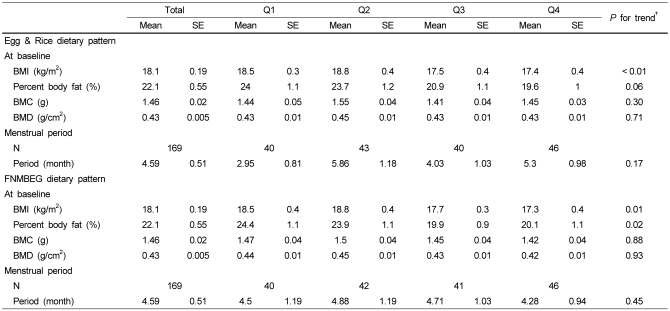
 XML Download
XML Download